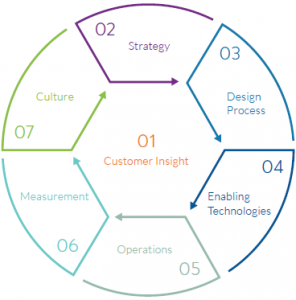The third of the seven customer experience (CX) dimensions discussed in Perficient Digital’s CX guide is Design Process. Once you have your customer insights (first dimension) and your strategy (second dimension), the next step is to tackle design. Remember that, in life sciences, “customer” means many things (e.g., patient, physician, clinical site, clinical subject, research partner, regulatory agency, vendor, employee) and that you will likely have a separate strategy for each of these customer groups.
Design Process “Dream Team”
The design process is used to envision, plan, and create CX using a mix of science and art, technology, and operational problem-solving. The most successful CX design initiatives are highly collaborative, with active involvement from business, creative, and technology teams. These teams clarify project goals, develop a solid foundation of customer needs, apply design thinking principles such as rapid prototyping, and perform ongoing evaluation of customers through various phases of development.
CX leaders adhere to the following standards for all digital design projects:
- Project objectives are linked to a CX key performance indicator (KPI) and are justified by customer insight (first dimension)
- User experience (UX) and digital design standards are effectively documented to ensure consistency across all digital touchpoints
- An iterative design methodology is used to create an end product that meets user expectations
- The project plan is structured to support collaboration between UX, technology, and marketing teams
- A UX leader is empowered to maintain CX integrity, as inevitable executional compromises are made
- A formal evaluation is conducted with customers to verify effectiveness prior to launch
Best Practice: Use Design Thinking to Create Desired Outcomes
The concept of design thinking has been around since the 1980s, but hasn’t gained a lot of traction in life sciences, outside of marketing. For those of you who aren’t familiar with it, this brief, but engaging, YouTube video does a nice job of describing it.
The general idea is to keep an open mind while you:
- Identify a problem to be solved
- Gather data (especially from humans)
- Identify patterns in the data that inform the design of your solution
- Vet your solution with end users
- Evolve your solution until your end users love it
In the next post, I’ll discuss the fourth dimension of CX: Enabling Technologies.

